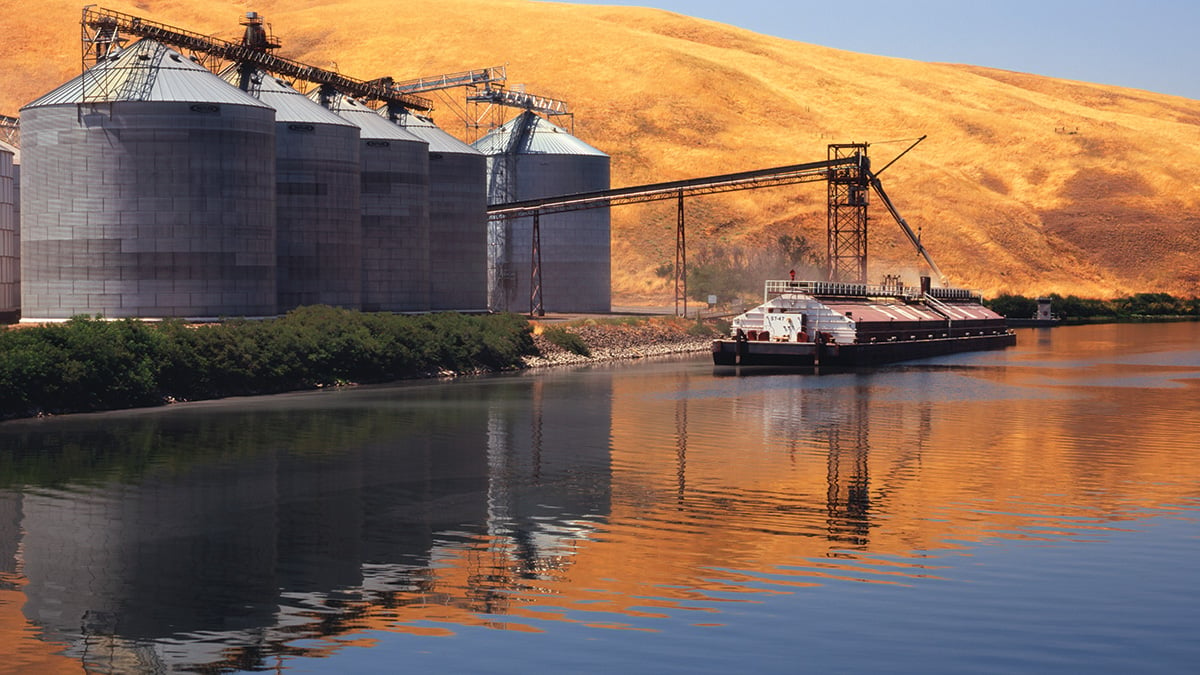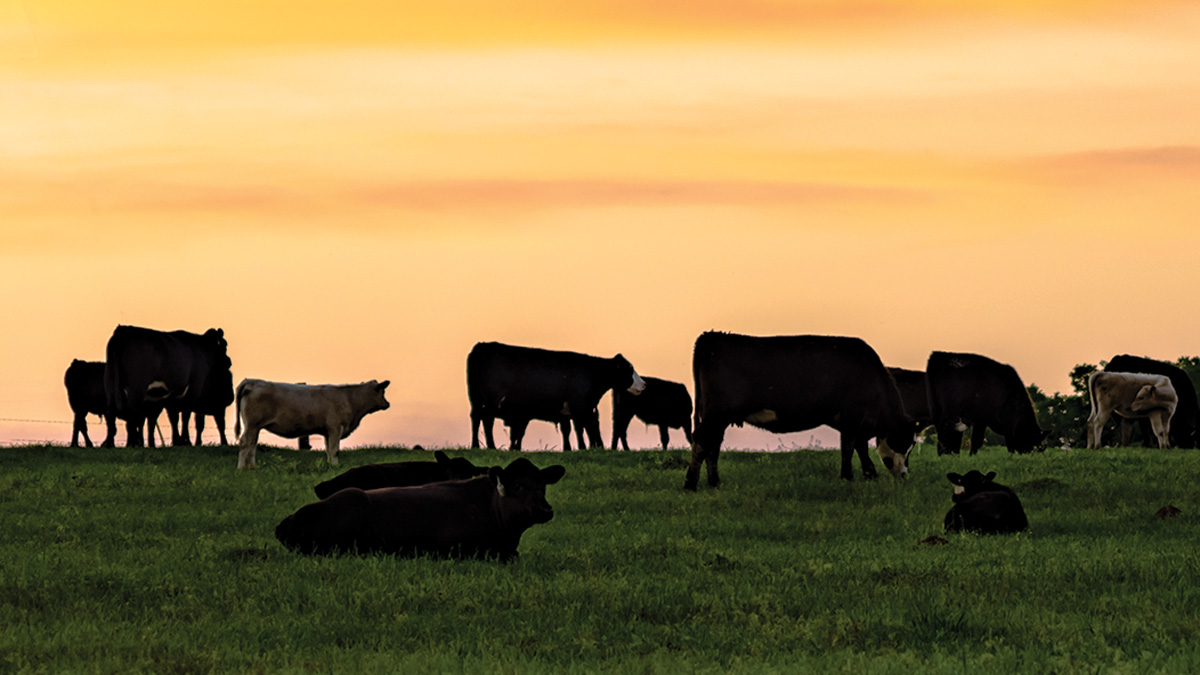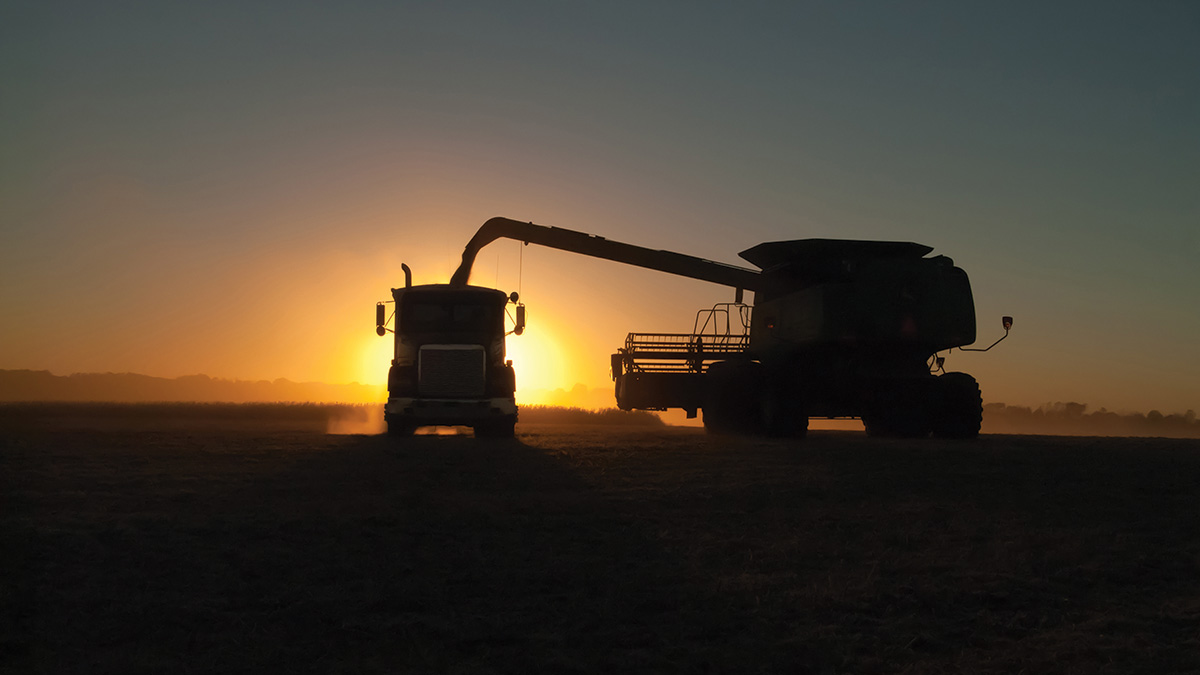Ordering Up Optimism
Despite inflation and supply chain turmoil across the food system, Wells Fargo’s chief agricultural economist sees hope on the horizon.

Michael Swanson has worked across the United States and around the world in the bowels of the global agricultural and food processing business—from grain-trading pits in Colombia to cheese plants in Wisconsin to rail corridors in Montana. So the chief agricultural economist for Wells Fargo is very familiar with the levers of commerce in the food business, from drought devastation to shipping breakdowns, from planting to processing, from the pricing vagaries of a worldwide market to the meteor-sized impact of black swan events such as the war in Ukraine.
That’s why it should be reassuring to those in the industry that Swanson isn’t particularly alarmed by recent trends in the business that include epochal inflation rates, crippling supply chain snarls, hair-on-fire labor shortages, and unprecedented out-of-stock situations.
“I really do see some good things happening,” says Swanson, who has been with Wells Fargo for two decades and works out of the giant bank’s office in Minneapolis. He points to an improved situation in the processing industry as an example.
“Right now we’ve got the greatest number of people working in food manufacturing and trucking that we’ve ever had, per payroll numbers,” he says. “So the good news is that companies are finding people willing to work. I mean, it’s not cheap. But the situation is certainly better than six months ago, when they were short-staffed, and it’s certainly better than through the [COVID] Omicron wave. Absenteeism is down; turnover is down. But, of course, I’ve yet to meet someone who says, ‘We’re perfectly fine.’”
Swanson’s long career in the business has included stints with Burlington Northern Railway, Cargill, and Land O’ Lakes. At Wells Fargo, America’s largest commercial agricultural lender, Swanson’s responsibilities include analyzing the impact of energy on agriculture, forecasting for agricultural commodities such as wheat and soybeans, prognosticating developments in key livestock sectors, and helping develop credit and risk strategies for Wells Fargo customers. Swanson also performs macroeconomic and international analysis of agricultural production and agribusiness.
He talked with Food Technology about the food industry’s current difficulties with inflation and the supply chain, how it impacts CPG companies and retailers, the current tensions between livestock producers and meat processing giants, the future of e-commerce in the business, and whether American farmers can take better advantage of the turmoil.
Q: You’ve worked in many different phases of the agriculture and food industries. How do you take all those varied experiences and form the lens that helps you execute your duties for Wells Fargo, which seem just as varied?
Swanson: I think of it as a mosaic with a bunch of different tiles. There are crop outlooks and machinery purchasing seen through the lens of farming. It flows from there into livestock and food manufacturers and transportation and biofuels. There’s a lot of overlap from there into food manufacturing and the CPG world. Then it flows into the tile representing food retailers and the foodservice side, such as Alliant or Sysco.
We finance every single one of the tiles in that mosaic. That allows us to understand the upstream and downstream concerns that people around the mosaic have. And I’ve participated myself in every single one of those tiles.
Q: So with that kind of systemic understanding, what is your perspective on why CPG prices are continuing to increase?
Swanson: CPG companies are always concerned about availability and price, and most days for them, availability is more important than price. There’s some of the dog chasing its tail here, the chicken or the egg. A lot of companies we work with have been very proactive in looking for price increases because they feel food buyers are willing to accept them right now with everything that is going on.
And they would be negligent as a food manufacturer not asking for these increases right now because they’ve seen pretty significant wage pressure. So raising prices a few percent would be reasonable. That’s a big piece of it. And now we’re seeing ingredient price increases as well.
But having said that, it’s a very competitive industry. And what’s very different about this environment now is that companies are more focused on margin than on market share. When you’re a big CPG company, one of the biggest drivers you always have is: Can you capture more share? You have fixed costs. If you can supply 24% of the market instead of 20%, that additional 4% [share] helps efficiencies and profit margins.
But right now these companies are often in the position—when they’re short on packaging or something else—of being concerned about where is the best margin.
Q: There are a lot of media reports about grocery store out-of-stocks, which is very unsettling to American consumers who may never have seen such a situation before. Is it really that bad?
Swanson: It’s interesting how things can be a trailing problem and not a leading problem. And people can talk about out-of-stocks, but my question back to them is: How do you know that? The information is almost always anecdotal. You have to rely on some kind of consistent data, but I don’t think I’ve ever seen a truly consistent out-of-stocks measurement.
A lot of what is happening is, for example, when you think about butter, a shopper is thinking about a particular package size in a particular brand. But if they can’t find a Land O’Lakes one-pound package of butter in quarter sticks in their supermarket, they’re like, “We have an out of stock.” Yet it’s not that they can’t find butter, but about what they can’t find that day.
Q: One way some companies are responding to supply chain and cost pressures is to rationalize their product lines. Do you see this happening to a significant extent?
Swanson: There’s the old saw in the industry that it’s easier to kill a vampire than to kill an SKU. When you have a sales force and brokerage, those people you work with are very sensitive to customer demand—that customers want a two-pack, not a four-pack, and they want all the flavors. Even if you look at that and say, “It’s killing my margins,” you can’t have their business if you don’t supply it all. Plus, manufacturers do it to themselves with line extensions and new varieties.
But we’re in a very unusual time. A lot of CPG companies and other manufacturers are saying that this is a good time for them to really rationalize and say to their sales forces and to brokerages: “You can’t have it all. We’re going to rationalize our product lines.” That gives them longer runs, less packaging to manage, and fewer warehouse complications. But there’s always pushback.
Q: Where does the pushback come from? Retailers? Or customers?
Swanson: Both. I consider them the same group. Retailers are there to serve their customers. And customers love options. They want 14 flavors of yogurt from four manufacturers—nonfat, full fat, six-ounce cups, eight-ounce cups—as long as they don’t have to pay for the privilege. Everyone likes selection, but there’s the back-and-forth of profitability. The retailer with the best selection has the best foot traffic, but it comes at a cost.
Occasionally we go through this situation where the manufacturer has the upper hand in SKU reduction. One of the ways they can get past the gatekeepers for restricting price increases to 1% over last year, or whatever, is to introduce a new product. Then you set the price then and there, and you don’t have to refer to last year’s price. There have still been lots of introductions of new products as a way to get past this gatekeeping mechanism that retail buyers have.
Q: Where does this new era leave digital availability, delivery mechanisms, and e-commerce in general, which flourished during COVID?
Swanson: We saw, like everyone else, that huge jump in curbside delivery during the pandemic, but we also have seen that pushed back recently. It’s very expensive. A lot of retailers made huge efforts to open up that channel, and they have the investment and infrastructure in place and will leave that channel there.
Some purchasers will still be willing to use that and to pay for it, to save time. But a lot of people have found out, who’ve been using Uber Eats or Grubhub, that when they go to the store themselves and get the same stuff, they find out how much was being added to their tab. And they’re like, “It’s convenient, but for seven or eight or 10 dollars per order, I’m not going to do that anymore.”
The perishability issue also has rolled some things back. It’s one thing to be delivering beef jerky to someone’s door but another thing to be delivering fresh meat. There’s a case to be made for delivery of some specialty products like coffee, tea, and spices, where they’re shelf stable and light and small, and you can ship them via a UPS flat package.
Q: Supply chain issues, of course, have been dogging the food business for the last couple of years. Then the Ukraine war affected supply chains for energy right away and created fears that the world would not be able to get the wheat, corn, and even sunflower oil that they’re used to getting from Ukraine. How is all of this going to affect the future of the supply chain in the food business?
Swanson: Most U.S. ingredients are produced locally, but there could be key components missing sometimes, especially a specialty ingredient or spices. And companies are finding out they can be hostage to that missing 1% of their inputs. So I think the just-in-time, limited-inventory model is being reevaluated around those critical, small cost components. A lot of the business will go back to “just in case” instead of just in time.
But it’s interesting right now because companies are always trying to do this at the lowest cost. If they carry a lot of excess inventory, they run the risk of spoilage, and they also have the cost to carry. It’s not as simple as just covering yourself up with inventory. Companies need to be careful and look at the crucial ingredients with widespread supply chains that can be cut off quickly. But to go back to the 1970s and carry lots of inventory, with high intakes? Many CEOs and CFOs won’t reverse and go back to that.
Q: One major point of contention in the supply chain these days is between livestock owners and the handful of giant meat companies, with the farmers and ranchers alleging that they’re not getting anywhere near their fair share of rising meat prices and that the big processors are hogging the margin all for themselves. What’s really going on there?
Swanson: This is perennial. Producers never feel they’re getting a fair share of the retail dollar, but to some degree they can point to a very skewed relationship over the last couple of years. COVID really slowed down the ability of packers to process animals. For a while, they couldn’t put people in their slaughter facilities. And when they did open up again, you saw spacing, where they couldn’t put as many people in the plant, and they had to slow down. That became the binding constraint, not the number of pigs and cattle.
But that’s not true anymore. That binding constraint, staffing, is back to where it was before; throughput capacity is back to where it was. So it’s very likely that the nominally very strong margins going to the packer now will revert to historical relationships. We watch this cycle over time. And there are times when packers lose money hand over fist, such as during the 2014 run-up in cattle prices, when they couldn’t pass all of it through. No one was sympathetic to packers at that time.
Q: What do you expect the long-term impact of the war in Ukraine to be on global agricultural supplies? And are there ways that American farmers and other agricultural interests can take advantage of a new opportunity, as deplorable as its origins may be?
Swanson: The war happened too close to planting season for American farmers to make major adjustments this year. They needed to have the seed, fertilizer, and equipment to do anything, and we were too close to the start of this crop year to really do that. If the war would have started last September, farmers could have done a lot more figuring on planting a double crop of, say, wheat and soybeans. But this was too close.
However, in 2023, farmers should absolutely consider this. If you look at Southern Illinois and Indiana, for example, farmers could do a double crop of spring wheat followed by soybeans. The amount of potential profitability from double-cropping is historically large now. If you give them another year to prepare for it, and prices are still available for them to do it, they’ll do a lot more of it.
Q: So, will the prices still be there?
Swanson: Not according to the Chicago Board of Trade. The forecast for the price of soft red winter wheat in July 2023, shows it will be back down to about $8 a bushel. That’s still good historically. But right now [as of late March], it’s $10.50 a bushel. This market does what it’s supposed to do: It panicked, then slowly digested the implications of the situation and came to a more sober judgment.
But good [farmer] operators, the more progressive farmers, may choose to double plant. They’re the ones who do best because they take advantage even of somewhat favorable options. Anyone can chase a home run, but good operators work on hitting singles and doubles every year.
Vital Statistics
Credentials: Undergraduate degrees in Business Administration and Economics, University of St. Thomas; Master’s and PhD, Applied Economics, University of Minnesota.
Earlier Career Highlights: Transportation analyst, Burlington Northern Railway; manager, Cafetera de Manizales subsidiary of Cargill, in Colombia; manager of the supply chain for cheese production for Land O’Lakes
Road Warrior: Over 20 years as an agricultural economist and consultant for Wells Fargo, he’s driven an estimated 10,000 highway miles visiting clients and groups such as granges and industry associations.
Read Him At: Swanson is a blogger for Wells Fargo on the Food for Thought platform.
Digital Exclusives

FIRST Fireside Chat Presentations
Fireside Chats bring the future into focus and discuss current trends and opportunities.

Business FIRST Presentations at IFT FIRST
The Business FIRST Stage tackles global issues and showcase trends in food, food tech, and the science of food. Business FIRST is presented by IFT's flagship magazine, Food Technology.
Food Technology Articles

How to Achieve EPR-Forward Packaging
In this two-part series, the author explores the history of Extended Producer Responsibility (EPR), what is needed to help EPR succeed, and how brands can best prepare for EPR.

Keeping the ESG Promise
An infographic describing food and beverage companies’ outlooks regarding ESG initiatives.

Gulfood conference highlights technology solutions to regional, global food problems
An overview of insights shared at the 2024 Gulfood Inspire conference in Dubai.

The New Not So Normal
Ongoing financial concerns will affect what, when, and where America eats in 2024, with consumers opting more often for multi-functional foods, frequent snacking, and easy-to-prepare meals.

Leveraging AI on the Road to Net Zero
Can artificial intelligence move us toward a more sustainable food industry?
Recent Brain Food

A New Day at the FDA
IFT weighs in on the agency’s future in the wake of the Reagan-Udall Report and FDA Commissioner Califf’s response.
Members Say IFT Offers Everything You Need to Prepare for an Uncertain Future
Learn how IFT boosts connections, efficiencies, and inspiration for its members.

More on the FDA's Food Traceability Final Rule
In a new white paper, our experts examine the FDA’s Food Traceability Final Rule implications—and its novel concepts first proposed by IFT.
Job Satisfaction in the Science of Food is High but Hindered by Pain Points
IFT’s 2022 Compensation and Career Path Report breaks it down.












